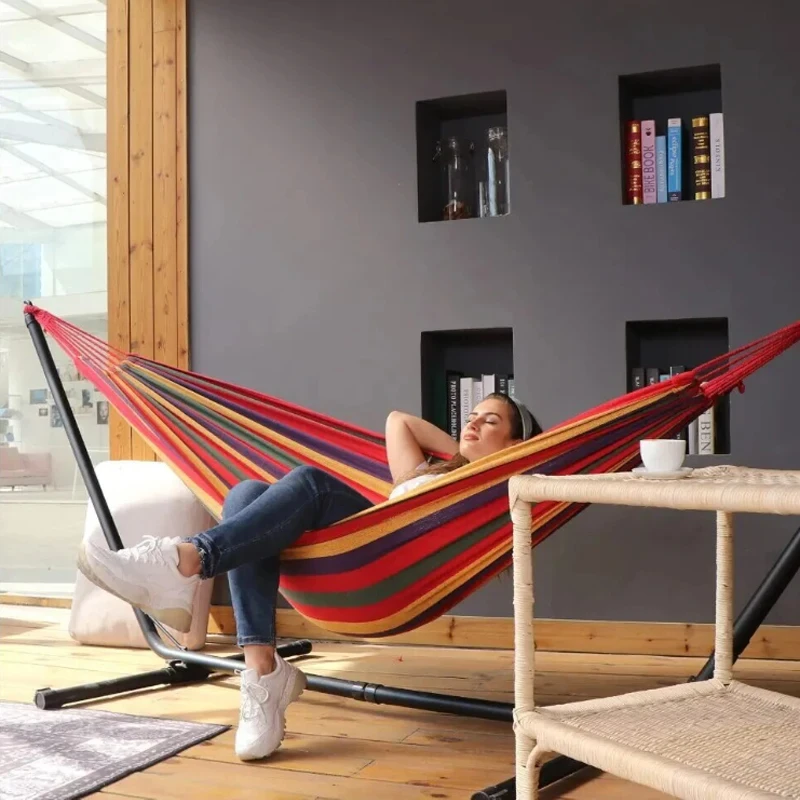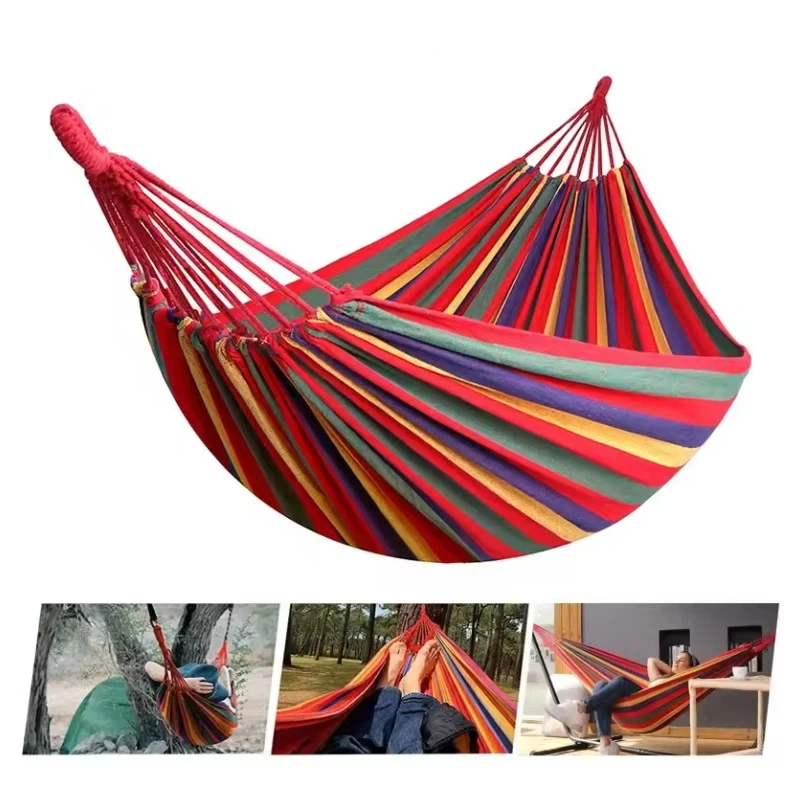The History of Hammocks
The hammock’s story is as relaxing as its use. It began over 1000 years ago. Native people in Central and South America created hammocks. They used woven tree bark or plant fibers. Hammock kept them off the ground. Away from snakes, insects, and dampness. Soon, they became a symbol of leisure and relaxation.
Hammocks spread with exploration and trade. European explorers took them back home. They became popular with sailors. Why? They saved space on ships and provided a comfortable sleep. Also, they swayed with the sea, reducing sickness.
Over time, the hammocks evolved. Different cultures added their touches. Materials and designs changed. But their core purpose — providing comfort and relaxation — stayed the same.
Today, hammocks are global. They come in various styles and materials. They suit all from backyard loungers to avid campers. ‘What is a hammock?’ one may ask. It’s a simple invention. It offers a unique way to rest, reflecting a rich history of innovation and adaptation.

Different Types of Hammocks and Their Characteristics
Exploring the different types of hammocks can enhance your relaxation experience. Each type has unique features catering to varied preferences and uses. Here’s an overview of the most common styles and their characteristics:
- Rope Hammocks: They feature a network of twisted ropes, typically made from cotton or polyester. These hammocks are breathable and perfect for warm environments. However, they offer less support compared to other types.
- Fabric Hammocks: Made from durable fabrics like cotton, canvas, or nylon, these hammocks are less breathable but provide more support and comfort. They are ideal for cooler climates and less buggy areas since the solid fabric protects against insects.
- Quilted Hammocks: These feature a layer of padding sandwiched between two fabric layers, offering enhanced comfort. They are perfect for cooler temperatures and are often found in vibrant patterns and colors.
- Camping Hammocks: Designed for hikers and outdoor enthusiasts, camping hammocks are lightweight and come with weather-resistant features like a mosquito net and rain cover. They are compact and easy to set up, making them ideal for adventure travel.
- Brazilian Hammocks: Known for their deep sag and fabric gathered at each end, Brazilian hammocks are incredibly cozy and well suited for sleeping. They typically lack spreader bars, allowing the fabric to wrap around your body.
- Mayan Hammocks: Hand-woven with thin, brightly colored strings, Mayan hammocks are very breathable and supportive. Their flexible weaving adjusts perfectly to the body’s contour, ideal for hotter climates.
Each hammock type serves a specific setting and need. Whether you seek comfort, portability, or aesthetic appeal, understanding these characteristics can guide you in choosing the right hammock for your leisure time.
The Ideal Locations for Hammock Setup
Choosing the right location for setting up your hammocks enhances your relaxation experience. Here are some top considerations for selecting the perfect hammocks spot:
- Shade and Sunlight: Find a balance between sunny and shaded areas. Too much sun can make the hammock hot and uncomfortable, while too much shade might keep it damp.
- Stable Anchors: Ensure the trees or poles used as anchors are strong and stable. They should be able to support your weight without bending or breaking.
- Open Area: Opt for a location that is free from clutter and obstacles. This ensures safety when getting in and out of the hammocks.
- View: Set up your hammocks in an area with a pleasant view. Whether it’s overlooking a garden, a lake, or mountains. A good view enhances the relaxation effect.
- Level Ground: Ensure the ground beneath the hammocks is flat and clear of rocks and roots. This provides safety in case of a fall.
When chosen wisely, a hammock’s location can transform a simple rest into a serene escape.
Essential Hammock Accessories
To make the most of your hammock, consider these essential accessories:
- Tree Straps: These protect the trees and provide a sturdy anchor for your hammocks.
- Carabiners: Heavy-duty carabiners are crucial for securing the hammocks to the straps or anchors.
- Hammock Stand: If trees aren’t available, a hammocks stand offers a portable solution.
- Underquilt: An underquilt keeps you warm from below, essential for cool weather lounging.
- Tarp: A tarp shields you from rain and provides shade on sunny days.
- Bug Net: A bug net keeps the insects away, ensuring an itch-free relaxation.
- Hammock Pillow: A specialized pillow adds extra comfort for your head and neck.
- Storage Bag: Keep your hammock protected and portable with a convenient storage bag.
These accessories can enhance your comfort, safety, and the overall experience of ‘what is a hammock’ when used properly. Each contributes to transforming your hammock into the ultimate relaxation spot.

Setting Up Your Hammock: Step-by-Step Guide
Setting up a hammock can seem tricky at first, but just follow these simple steps for a quick and safe setup:
- Choose Your Location: Refer to the earlier section on ideal locations. Find two strong, stable points about 12-15 feet apart.
- Attach Tree Straps: Wrap tree straps around your chosen points. Make sure they are about 4-5 feet from the ground. Pull tightly to secure.
- Attach the Hammock: Hook one end of the hammock to one of the straps using a carabiner. Repeat this on the other side. Adjust until the hammock hangs with a slight curve, not too tight or too loose.
- Test the Hammock: Gently sit on the hammock to test its stability and comfort. Adjust if necessary.
- Add Accessories: If desired, attach a bug net, underquilt, or tarp for weather protection and comfort.
By following these steps, you’ll ensure a safe and comfortable hammock setup. Enjoy your relaxation time!
The Do’s and Don’ts of Hammock Maintenance
Proper maintenance ensures your hammock lasts long and stays comfortable. Follow these simple guidelines to keep your hammock in top shape.
Do’s of Hammock Maintenance
- Clean Regularly: Wash your hammock according to its fabric type. Remove dirt and stains to prevent mildew.
- Dry Thoroughly: Always ensure your hammock is completely dry before storing. This prevents mold growth.
- Inspect for Wear: Check the ropes, fabric, and anchor points for signs of wear. Repair any damage promptly.
- Store Properly: When not in use, store your hammock in a cool, dry place. Use a storage bag to protect it from dust.
- Follow Manufacturer’s Instructions: Adhere to the care guidelines provided by the hammock manufacturer for best results.
Don’ts of Hammock Maintenance
- Avoid Harsh Chemicals: Do not use bleach or strong detergents. These can weaken the fabric and ropes.
- Keep Away from Sharp Objects: Prevent contact with sharp objects that can tear or snag the hammock.
- Don’t Overload: Respect the weight limit specified by the manufacturer to avoid strains and tears.
- Limit Sun Exposure: Prolonged sun exposure can fade and weaken the hammock’s material. Use it in shaded areas when possible.
- Avoid Leaving Out in Bad Weather: Do not leave your hammock out in rain or snow. Excessive moisture can damage it.
By following these maintenance tips, your hammock will be a lasting fixture for relaxation.
Advantages of Hammock Use
Enjoying the unique benefits of hammocks can greatly enhance your outdoor and relaxation experiences. Here are the key advantages when you ponder ‘what is a hammock’ and its use:
- Improved Sleep Quality: Hammocks can give a deeper sleep. Your body floats with no pressure points. This can mean waking up refreshed.
- Ultimate Relaxation: They sway gently. This motion can relax the mind, reducing stress.
- Compact and Portable: Most hammocks are easy to fold and carry. They are ideal for camping and hiking.
- Versatile Use: They’re great outdoors and indoors. Use them wherever you find two points to secure it.
- Health Benefits: Hammocks can ease back pain. The natural alignment of your spine helps relieve tension.
- Quick Setup: It takes only a few minutes to set up a hammock. Instant relaxation!
- Affordable Luxury: Compared to pricey furniture, hammocks offer a cozy retreat without the high cost.
Whether it’s for a better night’s sleep or to unwind after a long day, the benefits of hammock use are clear. They are not just a place to lounge, but also a way to improve health and wellbeing.

Hammock Safety: Tips and Best Practices
Ensuring your safety while enjoying a hammock is crucial. Here are essential tips and best practices:
- Check Weight Capacity: Always know your hammock’s weight limit. Never exceed it.
- Inspect Setup Before Use: Check all parts. This includes ropes, straps, and carabiners. Ensure there are no frays or weaknesses.
- Use Sturdy Anchors: Secure the hammock to robust trees or posts. Weak anchors can cause falls.
- Keep Low to the Ground: Set up your hammocks no more than 18 inches off the ground. This reduces injury risk if you fall.
- Avoid Sharp Objects: Clear the setup area of rocks, sticks, or any sharp objects.
- Use with Care: Get in and out of your hammocks gently to avoid tipping.
By following these guidelines, you can relax safely in your hammock and enjoy the peaceful moments.
